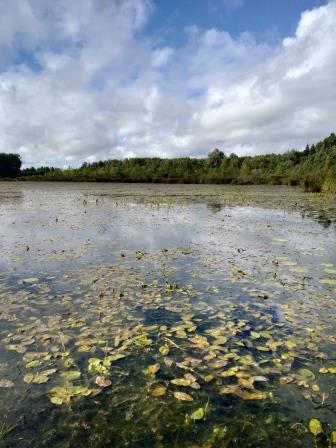Seasonal and interannual dynamics of zooplankton community characteristics of an overgrowing water body (on the example of Ilantovo lake of the Volzhko-Kamsky Reserve)
DOI:
https://doi.org/10.24852/2411-7374.2023.4.50.59Keywords:
zooplankton, structure, species diversity, higher aquatic vegetation, trophicity, Volzhko-Kamsky ReserveAbstract
This article presents the results of seasonal hydrochemical and hydrobiological studies of Ilantovo lake, located on the territory of the the Volzhko-Kamsky State Natural Biosphere Reserve. The researchers examined the distribution of invertebrate organisms in different areas of the lake, specifically the littoral and pelagic zone. They also explored the influence of higher aquatic vegetation on zooplankton communities and the seasonal variability in their structure. The lake’s zooplankton consisted of 110 species, primarily rotifers. There were identified 41 species of phytophilic zooplankton in macrophyte thickets. These thickets had different low species similarity among zooplankton communities. The littoral part of the lake showed high species diversity, but low abundance and biomass of zooplankton communities compared to the pelagial part. Significant fluctuations in zooplankton abundance and biomass are caused by mass development of some species, especially under favorable hydrothermal conditions. The index of zooplankton species diversity decreased with an increase in the lake’s trophic status.
References
Alekin O.A. Osnovy gidrohimii [Basics of hydrochemistry]. Leningrad: Gidrometeoizdat, 1970. 442 p.
Alekseev V.R., Glagolev S.M., Dobrynina T.I., Kotov A.A., Kutikova L.A., Mazej Yu.A., Malyavin S.A., Naumova E.Yu., Sinev A.Yu., Smirnov N.N., Stepanova L.A., Stojko T.G., Suhih N.M., Telesh I.V., Fefilova E.B., Fil'chakov V.A. Opredelitel' zooplanktona i zoobentosa presnyh vod Evropejskoj Rossii [Determinator of zooplankton and zoobenthos of fresh waters of European Russia]. Vol. 1. Zooplankton. Moskva [Moscow]: Tovarishchestvo nauchnyh izdanij KMK [KMK Scientific Press Ltd]. 2010. 495 p.
Borisovich M.G., Yakovlev V.A. Troficheskaya struktura zooplanktona raznotipnyh melkovodij Volzhskogo i Volzhsko-Kamskogo plesov Kujbyshevskogo vodohranilishcha [Trophic structure of zooplankton of different types of shallow waters of the Volga and Volga-Kama splashes of the Kuibyshev reservoir] // Uchenye zapiski Kazanskogo universiteta [Scientific notes of Kazan University]. 2011. № 2. P. 214–227.
Zimbalevskaya L.N. Struktura i sukcessiya litoral'nyh biocenozov dneprovskih vodohranilishch [Structure and succession of littoral biocenoses of Dnieper reservoirs]. Institut gidrobiologii [Institute of Hydrobiology]. Kiev: Naukova dumka. 1987. 203 p.
Derevenskaya O.Yu., Unkovskaya E.N. Struktura soobshchestv zooplanktona ozer Volzhsko-Kamskogo zapovednika [Structure of zooplankton communities in lakes of the Volzhsko-Kamsky Reserve] // Trudy Zoologicheskogo institute RAN [Proceedings of the Zoological Institute RAS]. 2016. №3. P. 294–303.
Kitaev S.P. Ekologicheskie osnovy bioproduktivnosti ozer raznyh prirodnyh zon [Ecological bases of bioproductivity of lakes of different natural zones]. Moscow: Nauka, 1984. 207 p.
Kosova M.V., Derevenskaya O.YU., Unkovskaya E.N. Ekologicheskoe sostoyanie ozer Volzhsko-Kamskogo gosudarstvennogo prirodnogo biosfernogo zapovednika na osnove bioindikacionnom metoda [Ecological state of lakes of the Volzhsko-Kamsky State Natural Biosphere Reserve on the basis of bioindication method] // Problemy ekologii Volzhskogo bassejna «VOLGA-2021» [Problems of ecology of the Volga basin «VOLGA-2021»]. Nizhny Novgorod, 2021. № 4. P. 1–3.
Krivenkova I.F. Znachenie fitofil'nogo zooplanktona dlya ekosistemy ozera Kenon [Importance of phytophilic zooplankton for the ecosystem of Lake Kenon] // Uchyonye zapiski Zabajkal'skogo gosudarstvennogo universiteta [Academic Notes of the Transbaikal State University]. 2018. № 1. P. 60–65. doi: 10.21209/2500-1701-2018-13- 1-60-65.
Kutikova L.A. Kolovratki fauny SSSR (Rotatoria). Podklass Eurotatoria (otryady Ploimida, Monimotrochida, Paedotrochida) [Rotifers of the fauna of the USSR (Rotatoria). Subclass Eurotatoria (orders Ploimida, Monimotrochida, Paedotrochida)]. Leningrad: Nauka, 1970. 744 p.
Makrushin A.V., Kutikova L.A. Sravnitel'naya ocenka metodov Pantle i Bukka v modifikacii Sladecheka i Zelinki i Marvana dlya opredeleniya stepeni zagryazneniya po zooplanktonu [Comparative evaluation of the Pantle and Bucca methods modified by Sladecek and Zelinka and Marwan for determining the degree of pollution by zooplankton] // Metody biologicheskogo analiza presnyh vod [Methods of biological analysis of fresh water]. Leningrad, 1976. P. 90-94.
Metodicheskie rekomendacii po sboru i obrabotke materialov pri gidrobiologicheskih issledovaniyah na presnovodnyh vodoemah [Methodological recommendations on collection and processing of materials for hydrobiological research in freshwater bodies]. Zooplankton i ego produkciya [Zooplankton and its production]. Leningrad, 1982. 33 p.
Muhortova O.V. Vidovoe raznoobrazie zoofitosa raznotipnyh vodoemov Samarskoj oblasti i Tatarstana [Species diversity of zoophytos of different types of water bodies of Samara region and Tatarstan] // Aktual'nye voprosy izucheniya mikro-, mejo- zoobentosa i fauny zaroslej presnovodnyh vodoemov [Actual issues of studying micro-, meio- and zoobenthos and fauna of freshwater bodies' thickets]. Nizhny Novgorod, 2007. P. 206–210.
Muhortova O.V., Unkovskaya E.N. Taksonomicheskij sostav fitofil'nogo kompleksa zooplanktona, formiruyushchegosya v makrofitah ozer Volzhsko-Kamskogo gosudarstvennogo prirodnogo biosfernogo zapovednika (Tatarstan) [Taxonomic composition of phytophilic zooplankton formed in the macrophytes of the lakes of the Volga-Kama State Biosphere Reserve (Tatarstan) // Izvestiya Penzenskogo gosudarstvennogo pedagogicheskogo universiteta imeni V. G. Belinskogo [Izvestia Penza State Pedagogical University named after V.G. Belinsky]. 2012. № 29. P. 159–164.
RD 52.24.643-2002. Metod kompleksnoj ocenki stepeni zagryaznennosti poverhnostnyh vod po gidrohimicheskim pokazatelyam [Method of complex assessment of surface water pollution degree by hydrochemical indicators].
Semenchenko V.P. [i dr.] Zooplankton litoral'noj zony ozer raznogo tipa [Zooplankton of littoral zone of lakes of different types]. Belorusskaya navuka [Belarusian science] 2013. 172 p.
Semenchenko V.P., Sushchenya L.M. Zakonomernosti raspredeleniya zooplanktona v litoral'noj zone evtrofnogo ozera [Regularities of zooplankton distribution in the littoral zone of a eutrophic lake] // Doklady NAN Belarus [Reports of the National Academy of Sciences of Belarus]. 2003. № 6. P. 74–76.
Tajsin A.S. Ozyora Prikazanskogo rajona, ih prirodnye i antropogennye izmeneniya [Lakes of Prikazansky district, their natural and anthropogenic changes]. Kazan' [Kazan], 2006. 167 p.
Sherysheva N.G., Verhovceva N.V., Osipov G.A., Unkovskaya E.N. Bakteriobentos pelagiali i zaroslej vysshih vodnyh rastenij ozera Ilantovo (VKGPBZ, Tatarstan) [Bacteriobenthos of pelagial and thickets of higher aquatic plants of Lake Ilantovo (VKSNBZ, Tatarstan)] // Izvestiya Samarskogo nauchnogo centra Rossijskoj akademii nauk [News of Samara scientific center of the RAS]. 2011. No 1. P. 174–179.

Downloads
Published
How to Cite
Issue
Section
License
Copyright (c) 2023 M.V. Kosova, O.Yu. Derevenskaya, E.N. Unkovskaya, N.V. Shurmina, F.M. Mukhametzyanova

This work is licensed under a Creative Commons Attribution-NonCommercial 4.0 International License.




